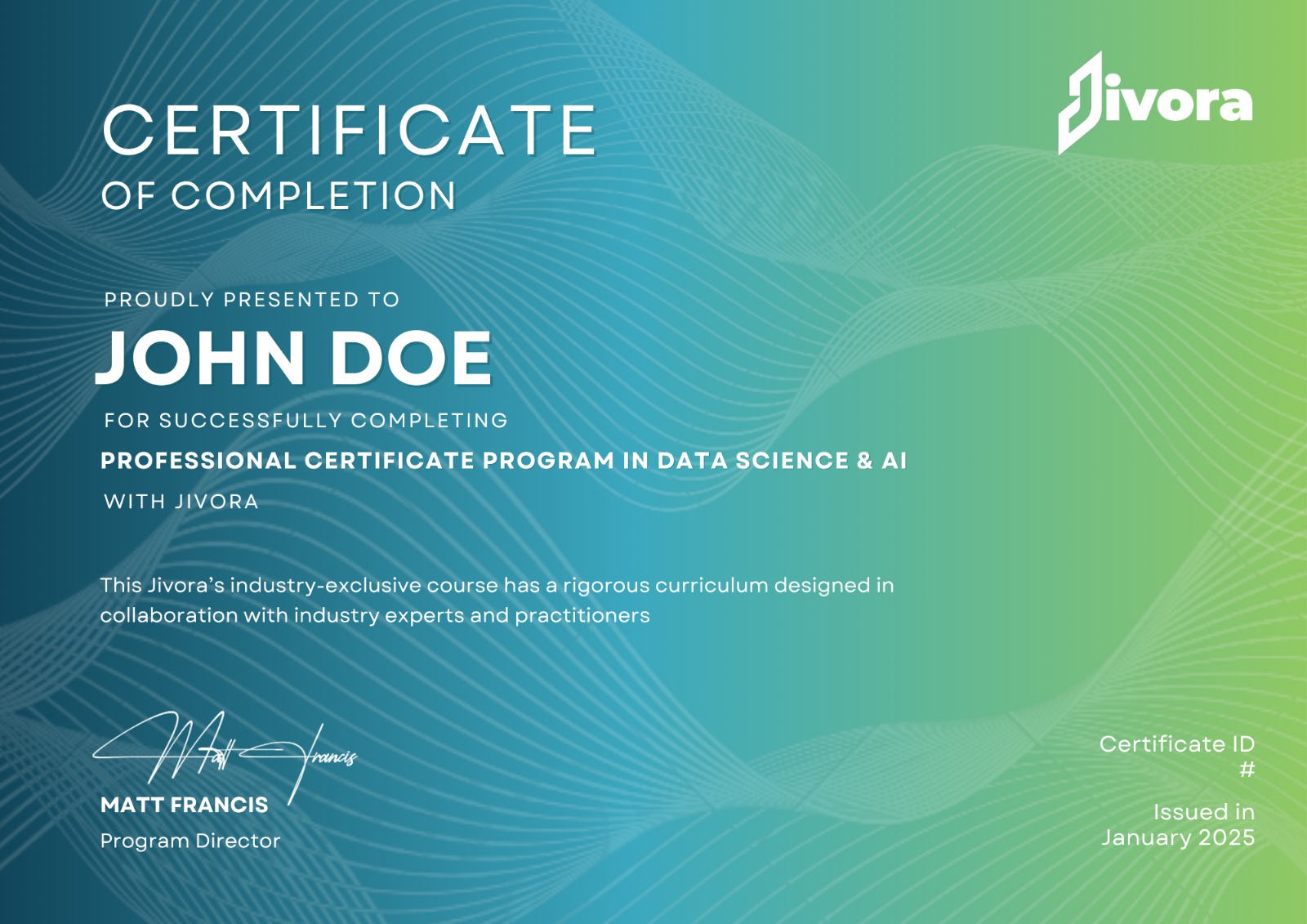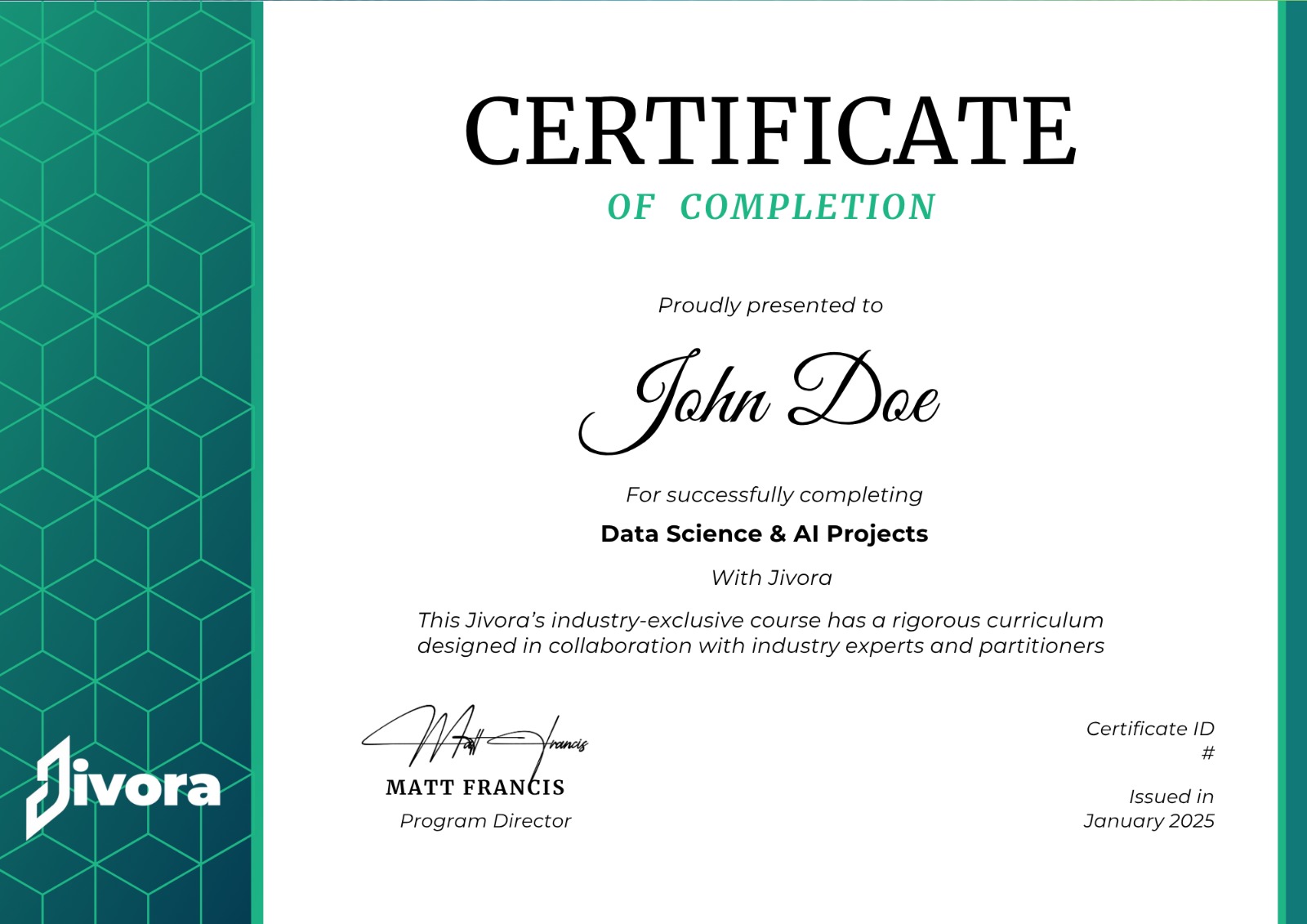
in collaboration with

Unlock your future with Jivora’s Data Science and AI program, a comprehensive 12-month course designed to make you industry-ready. Master key skills in machine learning, deep learning, Python programming, data analysis, and artificial intelligence with hands-on projects and expert mentorship.
Whether you're starting fresh or upskilling, Jivora’s Data Science and AI certification ensures you gain real-world knowledge, build a strong portfolio, and boost your career in today’s rapidly evolving tech landscape.
Join Jivora’s Data Science and AI program today to gain cutting-edge skills, real-world experience, and the confidence to launch a successful career in the rapidly growing tech industry.
Excel
Microsoft Excel is a versatile spreadsheet application widely used for organizing, analyzing, and visualizing data. Equipped with features like formulas, charts, and tables, it enables efficient management of data and is an essential tool for businesses.
Introduction to Excel
Basic Excel Concepts
Data Exploration Using Built-in Functions
Fundamental Visualization Techniques
Creating Charts and Graphs
Advance Excel
Advanced Excel expands on fundamental skills by introducing sophisticated data analysis techniques, complex formulas, pivot tables, macros, and automation capabilities. These tools empower professionals to handle and analyze data with greater accuracy and efficiency.
Functions
Lookup Methods
VLOOKUP, INDEX, HLOOKUP
Date and Time Functions
Data Tables and Validation
Pivot Tables
Financial Functions
Macros and Scripting
Custom Formatting and Advanced Filters
Dashboard Creation
Dashboard creation focuses on transforming data into meaningful narratives. By integrating key insights into visually appealing dashboards, learners can effectively convey findings, support informed decisions, and enhance presentations with data-driven stories.
Data Storytelling with Excel
Fundamentals of Dashboard Design
Building Advanced Dashboards
Establish a solid base in data science by mastering SQL for effective data management and exploring key principles of probability and statistics. Develop the ability to convert complex data into meaningful insights using Power BI, designing interactive dashboards and impactful visualizations. This module provides essential skills and tools to analyze, interpret, and communicate data clearly, enabling informed decision-making in real-world scenarios.
SQL
Gain expertise in both the foundational and advanced concepts of SQL (Structured Query Language), a vital skill for data science and AI professionals. This module focuses on efficient querying, filtering, and handling of large datasets within relational databases to extract valuable insights. Learners will also explore techniques to optimize query performance, manage complex data structures, and integrate SQL seamlessly into data science and AI workflows that address real-world challenges.
Introduction to Databases and Query Basics
Data Extraction Using SQL
Leveraging BigQuery for Large-Scale Data Analysis
Functions, Filtering, and Subqueries
Joins and Nested Queries for Complex Data Relationships
Aggregation and Grouping Methods
Date and Time Functions for Analytical Tasks
Indexing and Partitioning to Boost Query Efficiency
Probability & Statistics
Mathematics forms the essential foundation of Data Science, equipping learners with the tools needed to analyze data and derive meaningful insights. Core mathematical concepts such as statistics, probability, and linear algebra enable data scientists to identify patterns, validate models, and build algorithms that solve complex problems. These skills transform raw data into actionable knowledge that drives innovation and informed decision-making.
Probability and Bayes’ Theorem
Probability Distributions
Descriptive Statistics and Outlier Detection
Hypothesis Testing and A/B Testing
Analysis of Variance (ANOVA)
Correlation and Regression Analysis
Fundamentals of Linear Algebra and Matrix Operations
Power BI
Power BI is a dynamic business intelligence tool by Microsoft that plays a crucial role in modern data science workflows. This module equips learners with the ability to gather, clean, transform, and model data from multiple sources. Using Power Query and DAX (Data Analysis Expressions), learners will build interactive dashboards and insightful visualizations that drive impactful business decisions. The hands-on approach emphasizes real-time analytics, trend discovery, and performance tracking—core skills for aspiring data professionals.
Introduction to Power BI and Navigating the User Interface
Connecting, Cleaning, and Transforming Data with Power Query
Building and Refining Data Models for Deeper Analysis
Creating Effective and Interactive Visualizations
Leveraging DAX for Custom Metrics and Advanced Calculations
Designing Dashboards for Clarity and Interactivity
Compiling Full-Scale Business Reports
Applying Power BI to Real-World Case Studies and Scenarios
Embark on your data science journey with Python, a powerful and flexible programming language widely used in the industry. This module introduces you to essential concepts such as data cleaning, transformation, and visualization. Through practical exercises and hands-on projects, you’ll learn to work with datasets, extract meaningful patterns, and present your findings effectively—laying a strong technical foundation for advanced topics in analytics and machine learning.
Python Programming
Python is a widely-used programming language renowned for its clean syntax and ease of use, making it an ideal choice for beginners and professionals alike. In Jivora’s Data Science course, Python serves as a core tool for tasks such as data manipulation, analysis, and machine learning model development. Its support for multiple programming approaches—like object-oriented and functional programming—allows for flexibility in solving diverse data challenges. With robust libraries and frameworks tailored for analytics and AI, Python empowers learners to build practical, real-world data solutions efficiently.
Pandas
NumPy
Matpoltlib
Seaborn
Scikit-learn
TensorFlow
Data Wrangling
Data wrangling is the process of cleaning, transforming, and organizing raw datasets into a structured format ready for analysis. It plays a crucial role in preparing high-quality data by resolving issues like missing values, duplicates, and inconsistent formats. At Jivora, learners gain hands-on experience with essential tools and techniques to streamline the data preparation workflow and ensure accuracy for downstream tasks like visualization and modeling.
NumPy – Efficient handling of numerical data and arrays
Pandas – Powerful data manipulation and analysis with DataFrames
Data Acquisition – Techniques to gather data from various sources
Web Scraping – Extracting structured data from websites
BeautifulSoup – Parsing HTML and XML documents
Selenium – Automating web browsing tasks for dynamic data extraction
Data Visualization
Data visualization is the art of converting raw data into clear and meaningful visual formats such as graphs, charts, and interactive plots. This module empowers learners to turn complex datasets into intuitive visuals that reveal trends, highlight patterns, and expose anomalies. Effective visualization is not just about aesthetics—it enhances analytical thinking, enables data-driven storytelling, and supports better decision-making across business and technical domains.
Matpliolib
Seaborn
Plotly
Charting Techniques
Explore the core of machine learning with a deep understanding of algorithms, model training, and evaluation techniques. Gain a solid foundation in big data concepts, learning how to extract meaningful insights from large-scale datasets. This module also introduces ML Ops, focusing on the deployment, monitoring, and optimization of machine learning models in real-world environments. Designed for Jivora’s Data Science and AI program, this content equips learners with practical skills to build scalable, production-ready AI solutions.
Machine Learning
Machine Learning is a crucial component of the Data Science and AI landscape, where systems learn from data to identify patterns, make predictions, and automate decisions—without being explicitly programmed. In Jivora’s Data Science and AI program, learners gain practical expertise in applying ML techniques to real-world problems.
Regression and Classification Techniques
Decision Trees and Random Forest Algorithms
Clustering Methods, including DBSCAN
Exploratory Data Analysis (EDA)
Feature Engineering for Model Optimization
Model Development and Hyperparameter Tuning
Deep Learning
Deep Learning, an advanced area within machine learning, uses multi-layered neural networks to analyze complex patterns in large volumes of data. It’s particularly powerful for solving high-level tasks such as image classification, speech interpretation, and natural language understanding.
As part of Jivora’s Data Science and AI program, this module equips learners with practical and theoretical knowledge in:
Artificial Neural Networks (ANNs)
Hands-on implementation using TensorFlow and Keras
Understanding Forward and Backward Propagation
Hyperparameter Optimization Techniques
Model Visualization and Monitoring with TensorBoard
Computer Vision
Computer Vision, a specialized area within Artificial Intelligence, focuses on teaching machines to interpret and analyze visual data from images and videos—replicating the way humans perceive their surroundings. This technology powers a wide range of innovations, including facial recognition systems, autonomous driving, and medical image diagnostics.
Convolutional Neural Networks (CNNs)
Image Preprocessing and Data Augmentation Techniques
Tuning and Optimization of CNN Models
Understanding CNN Architectures such as AlexNet, VGG, and Inception
Techniques for Object Detection, Localization, and Segmentation
Generative Adversarial Networks (GANs) for Image Generation
MLOps
ML Ops (Machine Learning Operations) is a vital component of deploying AI solutions at scale. It bridges the gap between model development and production, ensuring that machine learning workflows are automated, efficient, and maintainable. ML Ops focuses on deploying, monitoring, and managing models in real-world environments while fostering collaboration between data science teams and operations
Building ML APIs using Flask
Introduction to Docker and Containerization for Model Portability
Model Lifecycle Management with MLflow
Continuous Integration/Continuous Deployment (CI/CD) Pipelines for ML
Implementing Scalable ML Workflows with AWS Services
Take your data science skills to the next level with advanced modules in Jivora’s Data Science and AI program. Dive into the fundamentals and real-world applications of deep learning, gain hands-on experience in computer vision, and uncover the capabilities of natural language processing (NLP). These advanced areas empower you to work on complex AI challenges, from image recognition to human language understanding. By mastering these technologies, you'll be well-prepared to create innovative solutions and stay ahead in the ever-evolving data science landscape.
Big Data
Big Data encompasses extremely large and intricate datasets that go beyond the capabilities of conventional data processing techniques. In the realm of Data Science and Artificial Intelligence, handling Big Data involves gathering, storing, and analyzing enormous volumes of information to uncover meaningful patterns and insights. This requires leveraging advanced tools and technologies designed to efficiently manage and process these vast datasets.
Big Data Fundamentals
Data Warehousing with Hive
Apache Spark
Big Data on Cloud Platforms (AWS)
NoSQL Databases
Natural Language Processing
Natural Language Processing, or NLP, is a key area of artificial intelligence that focuses on enabling computers to understand and interact with human language. It involves creating algorithms and models that allow machines to interpret, analyze, and generate text, making it essential for applications like chatbots, machine translation, sentiment analysis, and text summarization.
Text Preprocessing
Regular Expressions
Semantic Processing
Introduction to Deep NLP
Co-occurrence Matrix
Word Embedding
Latent Semantic Analysis
SkipGram & Word2Vec
Sentiment Analysis
Case Studies
Gen AI
Generative AI represents one of the most innovative frontiers in artificial intelligence. Unlike traditional AI systems that primarily analyze or classify data, generative AI focuses on creating new content by learning patterns from existing datasets. This technology powers a range of outputs—from human-like text and lifelike images to synthetic audio and video—using cutting-edge models such as GANs and transformers. It’s the engine behind modern chatbots, AI-generated art, and smart content automation tools, transforming how industries approach creativity and efficiency.
Introduction to Generative AI
Foundations of Deep Learning
Overview of Generative Models
Generative Adversarial Networks (GANs)
Variational Autoencoders (VAEs)
Transformers and Language Models
Synthetic Data Generation
Applications of Generative AI.
Ethical Considerations and Challenges
Capstone Project






Ready to take the next step in your career? Reach out to Jivora today — our team of expert career counsellors is here to guide, support, and empower your journey!
Expert and Professional Instructors
Career's Transformed
Over the World


Jivora’s Data Science and AI program was a game-changer for me. The hands-on projects and expert mentorship prepared me perfectly for real-world challenges. Highly recommend it!
The 12-month journey with Jivora was incredible. I learned everything from Python to deep learning, and the career support team helped me land my first tech job!
As someone switching careers, I found Jivora’s curriculum extremely practical and beginner-friendly. The personalized support made learning AI and machine learning much less intimidating.
Jivora’s program exceeded all my expectations. The course structure was clear, the content was up-to-date, and the capstone projects gave me an edge in interviews.
Choosing Jivora for my Data Science and AI education was the best decision. The instructors, resources, and job support services were absolutely outstanding.